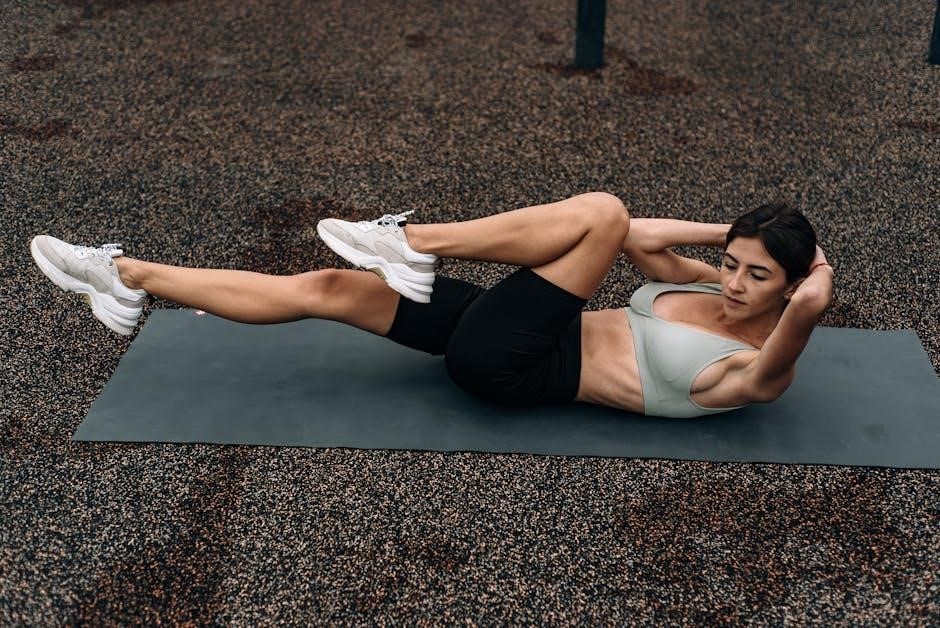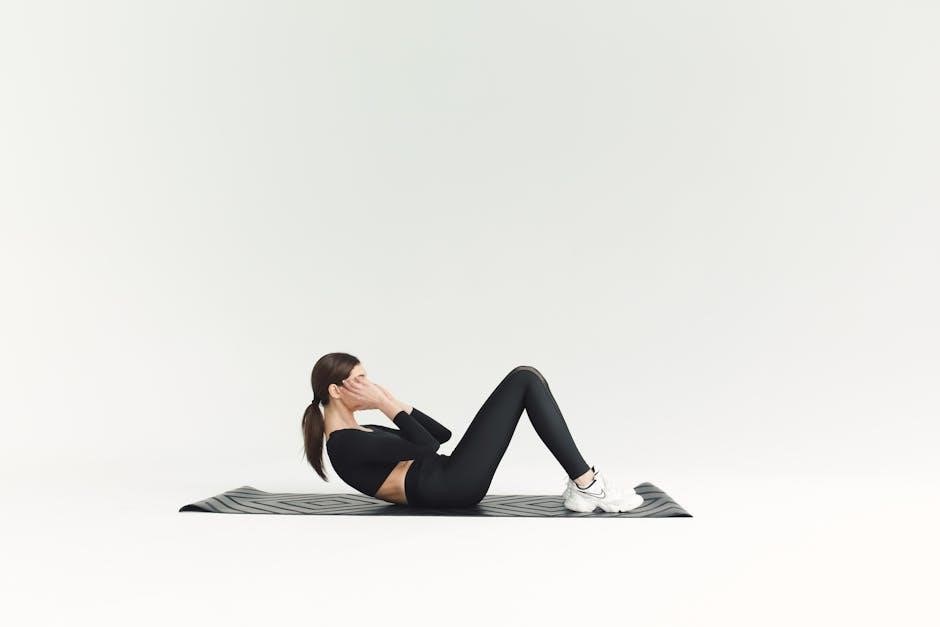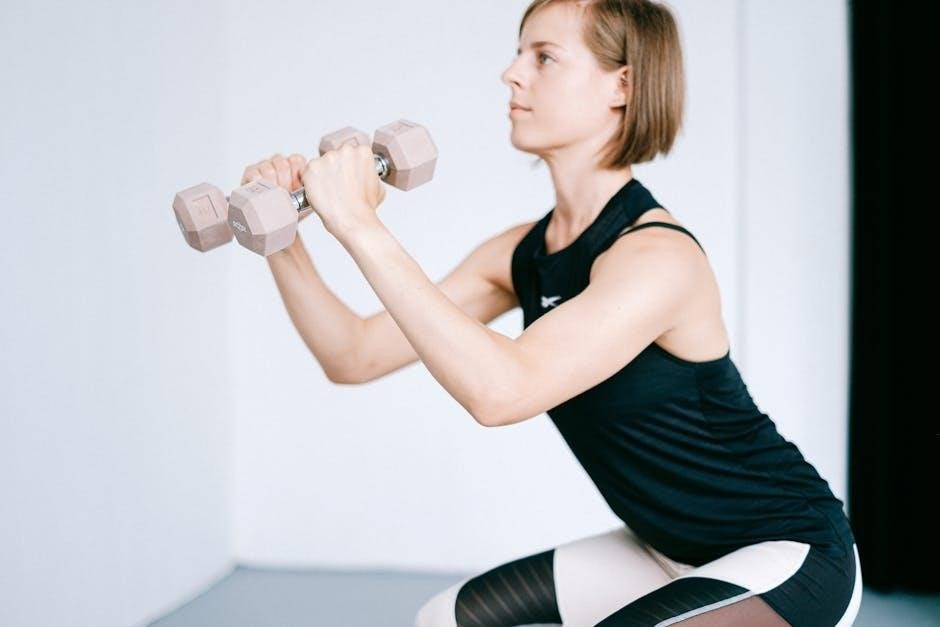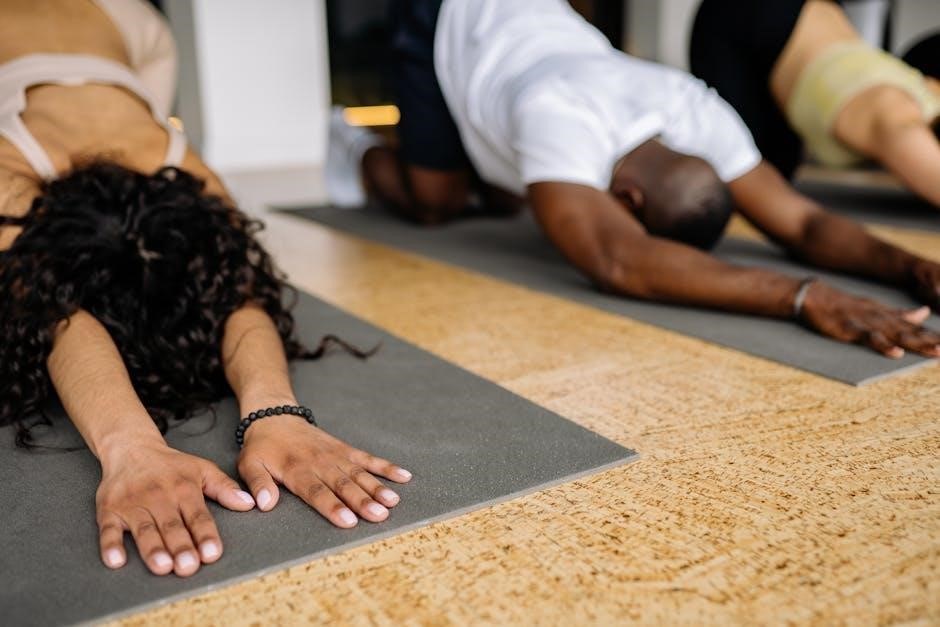
core workout pdf
A strong core enhances stability, balance, and posture, while improving athletic performance and reducing injury risk․ Core workouts are essential for overall fitness and well-being․
1․1 Importance of Core Strength
Core strength is vital for maintaining good posture, balance, and stability․ It enhances athletic performance, reduces injury risk, and improves overall physical stability․ A strong core supports daily activities, from lifting groceries to playing sports․ Weak core muscles can lead to poor posture and lower back pain․ Incorporating core exercises into your routine helps build a solid foundation for full-body strength and longevity․ Regular core workouts are essential for a healthy, active lifestyle․
1․2 Benefits of a Strong Core
A strong core improves posture, reduces back pain, and enhances athletic performance․ It boosts stability, balance, and endurance, aiding in both sports and daily activities․ Core strength supports better movement and overall physical stability, contributing to a stronger, leaner physique․ Regular core workouts can also improve digestion, reduce muscle soreness, and enhance mental focus․ Strengthening your core is essential for long-term fitness and overall well-being, making it a cornerstone of any effective exercise routine․

Key Components of a Core Workout
A core workout involves exercises targeting abdominal, oblique, and lower back muscles, often requiring minimal equipment like mats or resistance bands for dynamic and stabilizing movements․
2․1 Essential Core Muscles
The core comprises several key muscle groups, including the rectus abdominis, obliques, transverse abdominis, and erector spinae․ These muscles work together to provide stability, support the spine, and enable dynamic movements․ Strengthening these muscles improves posture, enhances athletic performance, and reduces the risk of injury․ A well-rounded core workout should target each of these groups to ensure comprehensive strength and stability․ Incorporating exercises like planks, crunches, and twists helps engage these essential muscles effectively․

2․2 Types of Core Exercises
Core exercises can be categorized into isometric, dynamic, and stability movements․ Isometric exercises, like planks, hold muscles in tension without movement․ Dynamic exercises, such as crunches and Russian twists, involve active muscle contractions․ Stability exercises, including bird dogs and single-leg stands, improve balance and control․ Each type targets different aspects of core strength, ensuring a well-rounded workout․ Combining these exercises helps build endurance, power, and overall core stability․ This variety keeps workouts engaging and effective for all fitness levels․
2․3 Equipment Needed
While many core exercises require minimal equipment, some tools can enhance your workouts․ A stability ball is ideal for crunches and Russian twists, while resistance bands add challenge to leg raises․ An exercise mat provides comfort for floor exercises like planks and dead bugs․ For advanced routines, weight plates or Kettlebells can be incorporated․ However, bodyweight exercises remain effective for building core strength, making it accessible for anyone to start without significant investment in equipment․

Top Core Exercises
Effective core exercises improve stability, strength, and overall fitness․ Planks, crunches, leg raises, and Russian twists are top choices for engaging core muscles efficiently․
3․1 Planks and Variations
Planks are a fundamental core exercise that strengthens the abs, obliques, and lower back․ They improve posture, balance, and overall stability․ Start with a forearm plank, engaging your core and holding a straight line from head to heels․ Variations include side planks for targeting obliques and inverted planks for advanced challenge․ Proper form is crucial to avoid strain․ Incorporate planks into your routine for a strong, stable core․ Consistency yields noticeable results in strength and posture․
3․2 Crunches and Reverse Crunches
Crunches and reverse crunches are classic exercises targeting the abdominal muscles․ Traditional crunches focus on the rectus abdominis, while reverse crunches engage the lower abs․ Lie on your back with knees bent for crunches, lifting your shoulders off the ground․ For reverse crunches, lift your hips instead․ Both exercises improve core strength and definition when performed correctly․ Aim for 3 sets of 15-20 reps to see noticeable results and enhance your six-pack definition․ Proper form is essential to avoid strain․
3․3 Leg Raises and Knee-to-Elbow Exercises
Leg raises target the lower abs, improving posture and balance․ Hang from a bar or lie on your back, lifting legs straight or bent․ Knee-to-elbow exercises engage the obliques by bringing knees toward the chest and elbows․ These exercises strengthen the core, enhance flexibility, and support overall stability․ Perform 3 sets of 12-15 reps for optimal results․ Maintain proper form to avoid injury and maximize muscle engagement․ Consistency will yield noticeable improvements in core strength and definition․
3․4 Russian Twists and Flutter Kicks
Russian twists target the obliques, enhancing rotational strength and stability․ Sit with knees bent, feet lifted, and twist your torso side to side, touching hands to the ground․ Flutter kicks engage the lower abs, improving core endurance․ Lie on your back, lift legs, and alternate kicking motions․ Perform 3 sets of 20-30 seconds for each exercise․ Use weights for added resistance and maintain controlled movements to avoid strain․ These exercises are versatile and effective for a strong, defined core․
3․5 Dead Bugs and Lateral Leg Rolls
Dead Bugs target the deep abdominal muscles, improving core stability and coordination․ Lie on your back, knees bent at 90 degrees, and alternate lowering one leg while maintaining pelvic neutral․ Perform 1 max set, aiming for 2-4 minutes․ Lateral Leg Rolls engage the obliques and lower abs․ Lie face-up, knees bent, and roll knees side to side with controlled movements․ Complete 2-4 sets of 4-6 reps, resting 30 seconds between sets․ These exercises enhance core strength and overall athletic performance effectively․

Creating a Core Workout Routine
A well-structured core workout routine begins with a warm-up, followed by strategic exercise selection, and ends with a cool-down to ensure maximum effectiveness and recovery․
4․1 Warm-Up and Cool-Down
A proper warm-up prepares your core muscles for exercise, reducing injury risk and improving performance․ Start with light cardio like jogging or jumping jacks, followed by dynamic stretches such as leg swings and torso twists․ Post-workout, cool down with static stretches for the hamstrings, hip flexors, and lower back․ Incorporate deep breathing exercises to promote relaxation and aid recovery․ A well-structured warm-up and cool-down routine ensures optimal preparation and recovery for your core workout․
4․2 Exercise Selection and Order
Effective core workouts require strategic exercise selection and ordering․ Begin with compound movements like planks and bird dogs to engage multiple muscle groups․ Progress to isolation exercises such as crunches and Russian twists for targeted muscle activation․ Incorporate functional exercises like dead bugs and lateral rolls to enhance real-world movement patterns․ Adjust the order based on fitness goals, ensuring a balanced routine that strengthens all core regions, from abdominals to obliques and lower back muscles․ This structured approach maximizes efficiency and results․
4․3 Frequency and Duration
Aim to train your core 2-3 times per week for optimal strength and stability․ Sessions should last 15-30 minutes, depending on intensity and exercise volume․ For beginners, shorter workouts with basic exercises are effective․ As fitness levels improve, gradually increase duration and frequency to challenge the core further․ Allow at least 48 hours of rest between core-focused workouts to promote recovery and muscle growth․ Consistency and balance are key to achieving lasting results․
4․4 Progressive Overload
To enhance core strength, incorporate progressive overload by gradually increasing exercise intensity․ This can be achieved by adding repetitions, sets, or time holds for exercises like planks or crunches․ Introduce more challenging variations, such as weighted crunches or stability ball exercises, as fitness levels improve․ Adding resistance bands or light weights can also amplify the workout’s effectiveness․ Over time, this method ensures continuous muscle growth and improved core stability, keeping the routine engaging and results-driven․

Core Workout for Beginners
Beginners can start with simple exercises like planks, crunches, and leg raises․ Focus on proper form and gradual progression to build a strong foundation safely and effectively․
5․1 Simple Exercises for Starting Out
For beginners, simple exercises like planks, bird dogs, and seated crunches are ideal․ Planks strengthen core stability, while bird dogs improve coordination and balance․ Seated crunches target the abdominals without strain․ Start with short sets and focus on proper form to avoid injury․ Gradually increase intensity as strength improves․ These exercises lay a solid foundation for more advanced routines, ensuring a safe and effective core workout journey․
5․2 3-Week Introductory Program
This 3-week program is designed for core workout beginners, focusing on foundational exercises to build strength and endurance․ Week 1 introduces basic exercises like planks and crunches, with short sets and breaks․ Week 2 increases intensity with added exercises like leg raises and Russian twists․ Week 3 combines all learned exercises into a full core circuit, promoting progressive overload for visible results․ Each week includes warm-ups and cool-downs, ensuring a balanced approach to core development․ This structured plan helps build a strong core safely and effectively․
5․3 Tips for Maintaining Form
Proper form is crucial for effective core workouts and injury prevention․ Engage your core by drawing your belly button toward your spine․ Maintain a neutral pelvis to avoid straining your lower back; Move slowly and controlled, avoiding jerky motions․ Focus on breathing naturally, exhaling during the exertion phase of exercises․ Keep shoulders relaxed and avoid using momentum․ Practice in front of a mirror to monitor your form, and consider working with a trainer for personalized feedback․ Consistency and attention to form yield the best results․

Advanced Core Workouts
Advanced core workouts target seasoned individuals, incorporating high-intensity exercises, dynamic movements, and resistance to build superior strength and stability․ They challenge endurance and functional power․
6․1 High-Intensity Exercises
High-intensity core exercises push your body to its limits, enhancing endurance and strength․ Dead Bugs, Lateral Leg Rolls, and V-ups are advanced movements that engage the entire core․ These exercises improve functional power and stability, essential for athletes and fitness enthusiasts․ Proper form and controlled movements are crucial to avoid injury and maximize results․ Incorporating these into your routine challenges your core like never before, fostering rapid progress and a stronger, more resilient midsection․
6․2 Core Challenges and Progressions
Core challenges push your limits, testing endurance and strength․ Advanced exercises like planks, crunches, and Russian twists can be modified to suit fitness levels․ Progress by increasing intensity, duration, or resistance․ For example, elevate your feet during crunches or add weights to Russian twists․ Consistency and proper form are key to overcoming challenges and achieving a stronger, more stable core․ These progressions help build resilience and enhance overall fitness․
6․3 Incorporating Weight and Resistance
Adding weights or resistance to core exercises intensifies workouts, building strength and muscle definition․ Use dumbbells, kettlebells, or resistance bands for exercises like weighted crunches or Russian twists․ For added challenge, incorporate weighted planks or leg raises․ Proper form is crucial to avoid injury and maximize results․ Start with lighter weights and gradually increase as you build strength․ This approach helps advance your core training, enhancing both stability and power effectively․

Nutrition for Core Strength
A balanced diet rich in protein, fiber, and healthy fats fuels core strength․ Include lean meats, fish, eggs, and whole grains․ Stay hydrated and avoid processed sugars․
7․1 Foods That Support Core Muscle Growth
Nourish your core with protein-rich foods like chicken, fish, and eggs to build muscle․ Include complex carbs such as brown rice and quinoa for energy․ Add healthy fats like avocados and nuts for recovery․ Incorporate fiber-rich vegetables to aid digestion․ Hydrate adequately with water and consider supplements like whey protein for muscle growth․ A balanced diet supports core strength and overall fitness goals effectively․
7․2 Hydration and Recovery
Proper hydration is crucial for muscle function and recovery․ Aim to drink at least 8-10 glasses of water daily, adjusting for sweat loss during workouts․ Incorporate electrolyte-rich beverages to maintain fluid balance․ Allow 48-72 hours of rest between core sessions to promote muscle repair․ Prioritize sleep quality for optimal recovery, as it enhances muscle regeneration and core strength․ Avoid sugary drinks and opt for herbal teas or coconut water to replenish nutrients effectively․
7․3 Meal Planning for Optimal Results
A well-structured meal plan is vital for core strength․ Focus on balanced meals rich in lean proteins, complex carbs, and healthy fats․ Include foods like chicken, fish, whole grains, and vegetables to fuel muscle growth․ Hydration is key, so drink plenty of water and consider electrolyte-rich beverages post-workout․ Plan meals around your training schedule to maximize energy and recovery․ Aim to eat protein-rich snacks within 30 minutes of exercise to support muscle repair and growth․

Common Mistakes in Core Workouts
Overtraining, poor form, and neglecting full core engagement are common mistakes․ Ensure proper technique and adequate rest to avoid injury and maximize results effectively․
8․1 Poor Form and Its Consequences
Poor form during core exercises can lead to injuries, muscle imbalances, and reduced effectiveness․ Neglecting proper core contraction or pelvic neutral can strain the lower back and joints․ Consistently poor form may result in chronic pain or limited mobility․ Always prioritize proper technique to avoid these consequences and ensure safe, effective workouts․
8․2 Overtraining and Recovery
Overtraining your core can lead to muscle fatigue, decreased performance, and increased injury risk․ Insufficient recovery time prevents muscles from healing and strengthening․ Aim for 48-72 hours of rest between intense core sessions․ Incorporate rest days and active recovery, like stretching or yoga, to promote muscle repair and maintain progress․ Overtraining hinders growth, so balance effort with adequate recovery for optimal results․
8․3 Neglecting Full Core Engagement
Neglecting full core engagement during workouts can lead to poor form and ineffective exercises․ Many people fail to activate all core muscles, focusing only on superficial movements․ This limits the effectiveness of exercises like planks and crunches․ Proper engagement involves drawing the belly button toward the spine and maintaining a neutral pelvis․ Consistency in proper form ensures balanced development and prevents muscle imbalances․ Always prioritize full core activation to maximize workout benefits and avoid injury risks․

Core Workout PDF Resources
Downloadable core workout PDFs offer structured guides, exercise routines, and nutrition tips for optimal results․ These resources help create effective workout plans for all fitness levels․
9․1 Downloadable Workout Plans
Downloadable core workout plans provide comprehensive guides with structured routines, exercise descriptions, and visual aids․ These PDFs often include variations of planks, crunches, and dynamic movements tailored for different fitness levels․ Many plans offer progressive challenges, ensuring continuous improvement․ They are ideal for home workouts, requiring minimal equipment and offering clear instructions to maintain proper form and maximize results․
- Structured routines for all fitness levels
- Detailed exercise descriptions and visuals
- Progressive challenges for continuous improvement
- Suitable for home workouts with minimal equipment
9․2 Printable Exercise Guides
Printable exercise guides offer convenient, visually structured plans for core workouts․ They typically include step-by-step instructions, photos, and sets/reps for exercises like crunches, planks, and leg raises․ These guides cater to all fitness levels, from beginners to advanced, and are easily portable for home or gym use․ Many feature progressive routines, ensuring steady improvement while maintaining proper form and technique․
- Step-by-step instructions with visuals
- Customizable for all fitness levels
- Portable for home or gym use
- Progressive routines for steady improvement
9․3 Free Online PDF Resources
Free online PDF resources provide accessible core workout plans, featuring detailed exercises, routines, and nutritional advice․ Websites like Darebee and personal trainers such as Mark Cundle offer downloadable guides with step-by-step instructions and photos․ These resources cater to all fitness levels, from beginners to advanced, and often include customizable workout plans․ They are ideal for those seeking structured, cost-effective ways to strengthen their core from home or the gym․
- Downloadable workout plans with visuals
- Customizable for all fitness levels
- Includes nutritional and recovery tips
A strong core is essential for overall fitness and injury prevention․ Utilize free online PDF resources for structured workout plans and track your progress consistently for lasting success․
10․1 Final Tips for Success
Consistency is key to building core strength․ Track your progress in a workout log to stay motivated․ Incorporate progressive overload to challenge your core muscles․ Prioritize proper nutrition and hydration for optimal recovery․ Rest days are crucial to avoid overtraining․ Focus on maintaining proper form to prevent injuries․ Engage your core fully during exercises for maximum effectiveness․ Stay disciplined and celebrate small achievements along your fitness journey․
10․2 Stay Consistent and Track Progress
Consistency is vital for core strength development․ Aim to perform core workouts 2-3 times weekly, allowing recovery between sessions․ Use a workout log to track exercises, sets, and reps․ Celebrate small victories, like mastering a challenging exercise or increasing endurance․ Share progress on social media for accountability․ Be patient, as core strength builds over time․ Regularly update your routine to avoid plateaus and ensure continuous improvement․ Stay committed and watch your core transform․